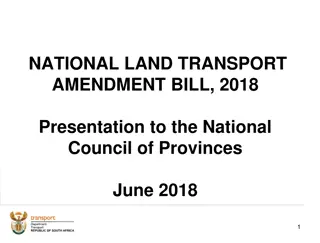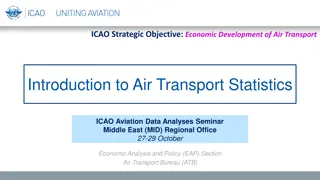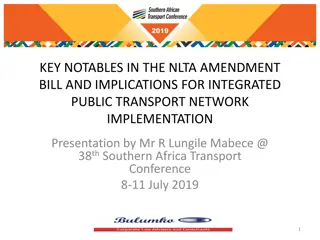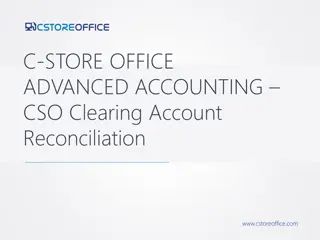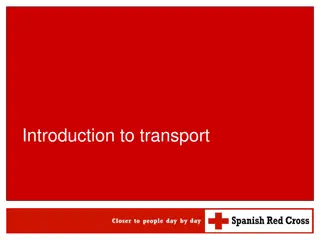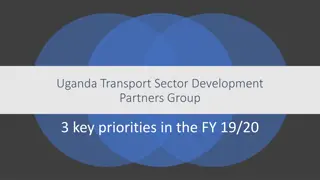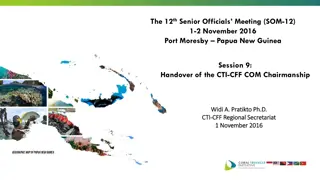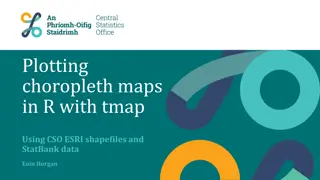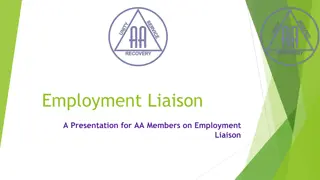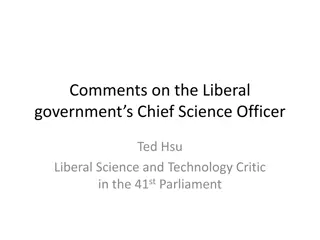Overview of CSO Environment Statistics Liaison Group Presentation on Transport-related Environment Statistics
The presentation outlines statistical releases relevant for transport statistics by CSO Environment and Climate division. It covers fuel excise clearances, fuel oil movements, environmental accounts, and more. The data is sourced from the Revenue Commissioners and offers insights into greenhouse gas emissions, trends in transport fuels, and traffic activity indicators. However, it does not delve into waste statistics or sustainable development aspects of transport. Work-in-progress releases include detailed editing of vehicle odometer data and analysis of the economic activity and decoupling from greenhouse gas emissions relationship.
- Transport statistics
- Environment statistics
- CSO releases
- Fuel excise clearances
- Greenhouse gas emissions
Uploaded on Sep 15, 2024 | 0 Views
Download Presentation

Please find below an Image/Link to download the presentation.
The content on the website is provided AS IS for your information and personal use only. It may not be sold, licensed, or shared on other websites without obtaining consent from the author. Download presentation by click this link. If you encounter any issues during the download, it is possible that the publisher has removed the file from their server.
E N D
Presentation Transcript
Transport Statistics Liaison Group 31 January 2023 3. Transport-related Environment Statistics Niamh Shanahan and Gerry Brady Niamh Shanahan and Gerry Brady Environment and Climate Division Environment and Climate Division
Overview of Presentation Overview of Presentation The presentation lists the statistical releases published by CSO Environment and Climate division that have some relevance for Transport statistics Some releases are very relevant e.g. monthly excise clearances of autodiesel and unleaded petrol which is consistent with traffic counter data Some releases have an indirect relevance e.g. identifying EV public charge point meters in the ESB meter dataset A web reference is given for the statistical releases - these contain detailed background notes on data sources, methodology, etc. Two work-in-progress releases are mentioned: a more detailed editing of the vehicle odometer microdata; and new work that will analyse the relationship between economic activity and decoupling from greenhouse gas emissions The presentation does not discuss waste statistics, sustainable development and circular economy aspects of transport e.g. disposal of vehicles, used tyres, engine oil, battery disposal, etc. 2
Relevant CSO Environment Releases Relevant CSO Environment Releases 1. Fuel excise clearances 2. Fuel oil movements (ROM1) 3. Environmental accounts air emissions 4. Environment taxes 5. Environmental subsidies and similar transfers 6. Fossil fuel subsidies 7. Business energy use survey 8. Metered electricity consumption 9. Networked gas consumption 10. Vehicle odometer readings 11. Decoupling emissions from economic activity 3
Fuel excise clearances Fuel excise clearances (monthly) Release https://www.cso.ie/en/statistics/energy/fuelexciseclearances/ Data source Revenue Commissioners (January 2000 to November 2022) Timeliness T+5 weeks Content Monthly clearances (start of supply distribution chain) of autodiesel, unleaded petrol, marked gas oil, and kerosene. Relevance for transport Estimates of greenhouse gas emissions for transport fuels, trends away from fossil fuels towards EVs, traffic activity indicator. Revenue has some information on use of blended and standalone transport biofuels. Quality Data are based on payments of excise duty. There are differences with the National Oil Reserves Agency (NORA) figures because companies can get an exemption from the NORA levy if they have sufficient oil stocks. 4
Fuel oil movements (ROM1) Fuel oil movements (ROM1) Release https://www.cso.ie/en/statistics/energy/fueloilmovements/ Data source Revenue Commissioners (2013-2021) Timeliness T+10 months Content Monthly returns from auto fuel and marked fuel traders of movements of autodiesel, unleaded petrol, marked gas oil, and kerosene. Relevance for transport Similar to fuel excise clearances but at county level and figures are available for forecourts. Microdata are used by CSO as input into other work e.g. Business Energy Use survey. Microdata could be examined for inland waterways and marine diesel final customers by searching customer names. Quality Data are submitted by oil traders to Revenue. Microdata required a lot of editing because traders submit revisions or incorrect units. Final customer is identified for deliveries above 2,000 litres a month. The results were adjusted to be consistent with the fuel excise clearances release. 5
Environmental accounts air emissions Environmental accounts air emissions https://www.cso.ie/en/statistics/environmentaccounts/environmentalaccountsairemissions/ Release Data source Environmental Protection Agency plus (2009-2020) Timeliness T+21 months Content EPA emissions inventory classified by NACE sector. Relevance for transport Emissions from road transport fuels are redistributed to final consumption NACE sectors including households i.e. the EPA emissions inventory category, Transport, is reallocated to the NACE sector using the vehicles. This could be done for electricity to further develop an emissions by final use sector view. Quality EPA emissions inventory provides totals and CSO use various data sources to adjust the data to include emissions by Irish residents abroad and to exclude emissions in Ireland by foreign residents (including fuel tourism). 6
Environment taxes Environment taxes Release https://www.cso.ie/en/statistics/environmentaccounts/environmenttaxes/ Data source CSO Government Accounts (2004-2021) Timeliness T+7 months Content Environment taxes by NACE sector and type of tax. Relevance for transport The amount of taxes collected under each transport tax and energy tax are given in the release. The Transport taxes are: vehicle registration tax; NCT levy; motor tax (business); motor tax (households); and vehicle and driving licence expenses. The split of motor tax between business and households is done by CSO Environment. Environment-related taxes can be used to influence consumer behaviours e.g. change to a carbon dioxide based tax for purchases of new vehicles in 2008. Quality Taxes paid data are of very good quality. CSO use various data sources to distribute each tax by NACE sector. 7
Environmental subsidies and similar transfers Environmental subsidies and similar transfers https://www.cso.ie/en/statistics/environmentaccounts/environmentalsubsidiesandsimilartransfers/ Release Data source Government departments and agencies (2000-2020) Timeliness T+15 months Content Environmental subsidies have an explicit environmental purpose. The results are classified by NACE sector and by Resource management or Environment protection purpose e.g. Protection of ambient air and climate; production of energy from renewable sources etc. Relevance for transport Release provides information on subsidies for purchasing EVs and for charging infrastructure. Quality For some subsidies only a proportion of the expenditure on a scheme is classified by the CSO as having a purpose of protecting the environment. The Background Notes accompanying the release contains information on any adjustments by the CSO. 8
Fossil fuel subsidies Fossil fuel subsidies Release https://www.cso.ie/en/statistics/environmentaccounts/fossilfuelsubsidies/ Data source Revenue Commissioners plus (2000-2020) Timeliness T+16 months Content Effective carbon rates by fuel; direct and indirect subsidies; and energy tax per litre (excise tax, carbon tax, NORA levy). Relevance for transport Reducing fossil fuel subsidies such as lower excise rates on marked gas oil and removing VAT refunds for fuel purchases by enterprises are relevant to the transition to a low carbon economy as they potentially incentivise the use of these fuels. Quality Data are based on various sources. The effective carbon rates are the preferred indicator for international comparison while the absolute amount of fossil fuel subsidies provides an indicator of revenue foregone at national level. 9
Business energy use survey Release https://www.cso.ie/en/statistics/energy/businessenergyuse/ Data source CSO / SEAI / EPA / Revenue / ESB / GNI (2009-2020) Timeliness T+23 months Content Quantities and costs of energy purchases by NACE sector and county. Relevance for transport The survey collects information on road, aviation, and marine transport fuels e.g. purchases of petrol, autodiesel, auto LPG, electricity, etc. Quality The survey returns are supplemented with a wide variety of additional administrative and survey data sources. The returns are weighted using the CSO Business Register. This bottom-up approach results in aggregates that do not exactly agree with SEAI top-down figures in the Energy Balances. SEAI use the survey results for a NACE sector distribution in the Energy Balances. 1 0
Metered electricity consumption Metered electricity consumption Release https://www.cso.ie/en/statistics/energy/meteredelectricityconsumption/ Data source ESB Networks (2015-2021) Timeliness T+5 months Content Metered electricity consumption by tariff, quarter, county, and Dublin postal district. Relevance for transport The file contains microdata relating to around 2.3 million meters. CSO Environment examined the customer file to identify EV public charge point meters as part of CSO work on statistics on the transition to EVs. Further work is possible to try to link owners of EVs and recipients of EV charger grants to the meter data. The installation of Smart meters may make it more possible to identify meters with night-time consumption that may be associated with charging. Quality The data are based on actual, customer, and estimated meter readings. Readings from Smart meters are actual. 1 1
Networked gas Networked gas consumption consumption Release https://www.cso.ie/en/statistics/energy/networkedgasconsumption/ Data source Gas Networks Ireland (2011-2021) Timeliness T+8 months Content Networked gas consumption by type of customer, quarter, county and Dublin postal district. Relevance for transport The consumption of natural gas by power plants is an element of the proportion of electricity not generated from renewables. As use of coal and peat to generate electricity decreases, the gas meter data will show whether those fuels have been replaced by gas. If the electricity to power EVs is from cleaner fossil fuels rather than from renewables then there will be emissions associated with the use of EVs. Quality For power plants, the meter readings are actual. 1 2
Vehicle odometer readings https://www.cso.ie/en/releasesandpublications/ep/p-tranom/transportomnibus2021/roadtrafficvolumes/ Release Data source NCT and CVRT (2000-2021) Timeliness T+10 months? Content Odometer readings from vehicle road worthiness tests. Relevance for transport Results can be disaggregated by fuel type and location to provide statistics on the use of autodiesel and petrol vehicles in comparison with EVs. If the odometer microdata could be linked with the sex and age of the owner then additional insights would be gained into road transport use - the files held by CSO Transport do not allow the vehicle file to be combined with the driver file. An Eircode would allow a more detailed analysis of differences in driving patterns and between rural and urban vehicle owners. Quality CSO Environment are examining the odometer data in relation to: incorrect recording of kilometres and miles; decimal place in odometer reading; tampering with the odometer; and the readings of old vehicles (e.g. 99999 to 0 instead of 100000). 1 3
Decoupling emissions from economic activity Release Work-in-progress Data source EPA and CSO (2015-2020?) Timeliness T+24 months? Content Analysis of trends in the economic activity of NACE sectors with high emissions. Relevance for transport Enterprises owning high numbers of diesel and unleaded petrol vehicles need to invest in a gradual transition towards lower emission fuel type vehicles. Quality The data are based on EPA greenhouse gas emissions inventory and CSO economic and employment statistics. The release is being developed as a time series analysis in the context of the Climate Action Plan targets. 1 4
1 5











